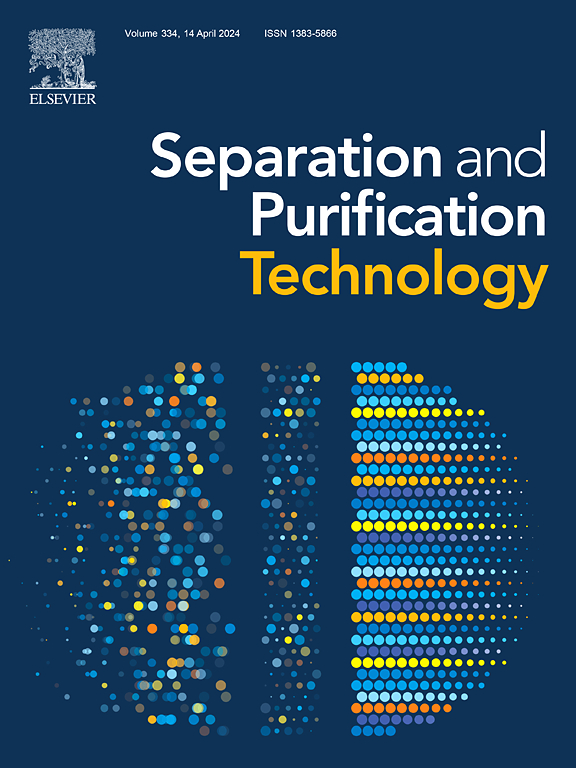Inherent safety evaluation and optimization for the separating tetrahydrofuran/methanol/water ternary system
IF 9
1区 工程技术
Q1 ENGINEERING, CHEMICAL
引用次数: 0
Abstract
The increasing scale of the chemical industry has attached growing importance to process safety. The distillation process is recognized as an energy-intensive process, therefore, the implementation of process intensification and optimization for energy-saving design necessitates an assessment of the inherent safety. In this work, we developed a comprehensive methodology including thermodynamic analysis, process intensification, optimization, and inherent safety evaluation for the tetrahydrofuran (THF)/methanol (MeOH)/water mixture separation. Firstly, the thermodynamic insights are employed to guide the distillation sequence design. Then, triple-column extractive distillation (TED), double-column reactive extractive distillation (DCRED), and reactive extractive dividing wall column (REDWC) are conceptually designed for the recovery of THF and MeOH from the mixture. A simultaneous optimization strategy based on the non-dominated sorting algorithm (NSGA-II) by taking total annual cost (TAC) and CO2 emissions as objective functions to optimize the process parameters. The inherent process risk index (IPRI) is adopted to evaluate the processes’ safety. Results show that the TAC of the TED, DCRED, and REDWC processes are 1.78 × 106 $/y, 1.25 × 106 $/y, and 1.41 × 106 $/y and the CO2 emissions of the three are 1,449 kg/h, 1,130 kg/h, and 1,292 kg/h respectively. DCRED process is superior to the other two processes in term of economic and environmental benefits. The results of IPRI indicate that the REDWC process exhibits superior performance compared to the other two processes. This work provides a systematic method combining optimization and inherent safety evaluation for multi-azeotrope mixture separation.

四氢呋喃/甲醇/水三元分离体系的固有安全性评价与优化
随着化工行业规模的不断扩大,过程安全问题日益受到重视。蒸馏过程是公认的能源密集型过程,因此,实施过程强化和优化节能设计需要对固有安全性进行评估。在这项工作中,我们开发了一个综合的方法,包括热力学分析,过程强化,优化和固有安全性评价的四氢呋喃(THF)/甲醇(MeOH)/水混合物分离。首先,利用热力学原理指导精馏流程设计。然后,从概念上设计了三塔萃取精馏(TED)、双塔反应萃取精馏(DCRED)和反应萃取分壁塔(REDWC)从混合物中回收THF和MeOH。以年总成本(TAC)和CO2排放为目标函数对工艺参数进行优化,提出了基于非支配排序算法(NSGA-II)的同步优化策略。采用固有过程风险指数(IPRI)对工艺安全性进行评价。结果表明,TED的TAC, dcr,和REDWC流程1.78 × 106美元/ y, 1.25 × 106美元/ y,和1.41 × 106美元/ y和二氧化碳排放的三个1449 kg / h, 1130 kg / h和1292分别 kg / h。DCRED工艺在经济效益和环境效益方面均优于其他两种工艺。IPRI结果表明,REDWC工艺性能优于其他两种工艺。本研究为多共沸混合物分离提供了一种优化与固有安全性评价相结合的系统方法。
本文章由计算机程序翻译,如有差异,请以英文原文为准。
求助全文
约1分钟内获得全文
求助全文
来源期刊

Separation and Purification Technology
工程技术-工程:化工
CiteScore
14.00
自引率
12.80%
发文量
2347
审稿时长
43 days
期刊介绍:
Separation and Purification Technology is a premier journal committed to sharing innovative methods for separation and purification in chemical and environmental engineering, encompassing both homogeneous solutions and heterogeneous mixtures. Our scope includes the separation and/or purification of liquids, vapors, and gases, as well as carbon capture and separation techniques. However, it's important to note that methods solely intended for analytical purposes are not within the scope of the journal. Additionally, disciplines such as soil science, polymer science, and metallurgy fall outside the purview of Separation and Purification Technology. Join us in advancing the field of separation and purification methods for sustainable solutions in chemical and environmental engineering.
 求助内容:
求助内容: 应助结果提醒方式:
应助结果提醒方式:


